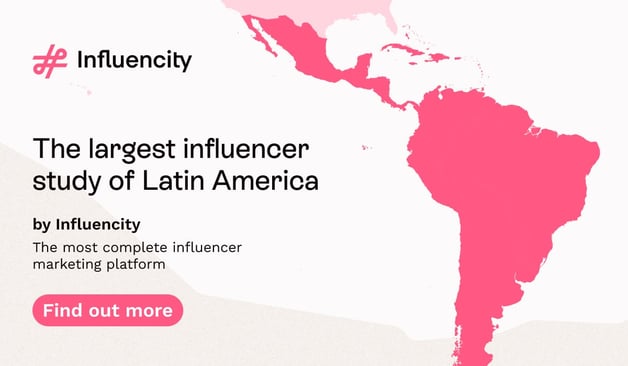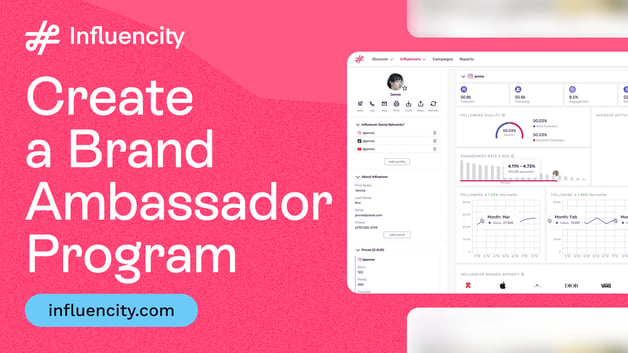Fake Influencers: What They Are and How to Detect Them
Influencer Marketing has grown into a powerful marketing tool that lets brands reach thousands of potential customers. With the right influencer, a brand can secure high returns on their investments. And there’s a very good reason behind why this happens.
People are more likely to purchase a product or service that’s been recommended to them by a family member, a friend, or someone they look up to. For a long time, magazines, billboards, TV ads and other forms of advertisements were how brands reached a large pool of potential customers. But the rise of social media brought people closer together in more ways than one.
Some highlights of today's post:
- Learn what defines a fake influencer and the tactics they use to deceive brands.
- Explore the financial and reputational risks associated with influencer fraud.
- Gain insights into tools and methods for identifying and avoiding fake influencers.
The Power Influencer Marketing
These days, you’re more likely to generate and convert leads by investing in a social media influencer. People now have the freedom to choose the content they want to engage with. This includes people on social media who they may not know or never meet. But through building these small online communities, people who follow certain influencers become interested in how that person lives and what they have to say.
Influencer marketing capitalizes on this relationship between a social media user and their followers. An influencer is paid a small fee in return for marketing a certain brand to their followers. The resulting sales made from that exchange can be far greater than through many traditional forms of advertising. That’s why many brands now consider influencer marketing to be a core part of their marketing and sales strategy.
For example, the fitness brand Gymshark has effectively leveraged influencer marketing to grow its brand. Gymshark partners with fitness influencers who showcase the brand's apparel in their workout videos, Instagram posts, and live sessions. One notable collaboration was with fitness influencer Nikki Blackketter, whose authentic and relatable content helped Gymshark reach a wider audience and significantly boost sales. This partnership not only increased Gymshark's visibility but also built credibility and trust with Nikki’s dedicated followers, translating into tangible sales and brand loyalty.
However, every coin has a flip side. Influencer marketing has the potential to help brands grow and expand their consumer base. It’s a very lucrative business for influencers, with top influencers earning hundreds of thousands of dollars from a single post. Yet, this prosperity has also attracted scammers, fraudsters, fake influencers and people looking to make a quick buck as well. For instance, in 2018, Unilever's CMO Keith Weed highlighted the issue of influencer fraud and called for greater transparency and action against such practices. This led to increased scrutiny and efforts to detect and combat fake influencers ever since.
To mitigate these risks, brands must invest in tools and strategies to identify genuine influencers. This involves analyzing engagement metrics, checking for consistent follower growth, and using platforms that offer detailed influencer analytics.
What Are Fake Influencers
Fake influencers are individuals who artificially inflate their social media presence to appear more influential than they truly are. This deceptive practice involves various tactics to create the illusion of having a significant following and engagement.
Here are some key characteristics and tactics of fake influencers and social media content creators:
- Bought followers. Fake influencers purchase followers to increase their follower count. These followers are often fake accounts or bots, which do not engage authentically.
- Engagement pods. Fake influencers join groups where members mutually agree to like, comment, and share each other's posts to boost engagement metrics artificially.
- Bot engagement. Fake influencers use automated bots to generate likes, comments, and shares on their content, creating the illusion of high engagement.
- Inauthentic content. Fake influencers may repost or steal content from other creators to maintain an active profile without genuinely creating original content.
- Misleading metrics. Fake influencers often have a high follower count but low genuine engagement, with most interactions coming from fake accounts or bots.
- Unusual growth patterns. Their follower growth may show sudden, unnatural spikes, indicating the purchase of followers.
Ultimately, collaborating with fake influencers can lead to wasted marketing budgets and poor campaign performance because their "influence" does not reach a real, engaged audience. To avoid this, brands are increasingly using tools and analytics to detect and avoid fake influencers, ensuring their partnerships are with authentic and impactful creators.
What is Influencer Fraud?
Building on the concept of fake influencers, influencer fraud encompasses the broader practice where individuals, bots, or groups create the illusion of influence without any real impact on social media platforms. This can significantly undermine the trust and effectiveness of influencer marketing.
Specifically, research conducted by Cheq, together with the University of Baltimore, revealed that the drive to prove that a social media account has a vast reach led to the birth of new fraudulent businesses. These exist for the sole purpose of creating and selling fake followers, creating fake engagements etc. for fake influencers.
Referencing a study from Paquet-Coulson, the Cheq research showed that people can ‘buy’ up to 1000 followers for YouTube for just $49. For Facebook, 1000 followers cost $34. The rates were even less for platforms like Instagram ($16) and Twitter ($15). Given that Instagram is the most commonly used influencer marketing platform, that’s bad news for businesses and brands who don’t do their background research.
Twitter, Instagram and other social media platforms immediately got to work to detect and remove fake accounts. In fact, the number of fake influencers on different social media platforms was so great that Twitter itself lost over seven million followers.
Instagram also conducted its own research to identify and analyze data related to fake influencers. The platform found that fake influencers are actually on the rise again. Once news of fake accounts with fake followers and low engagement rates became public knowledge, brands were understandably concerned.
Instagram introduced a measure where users who used third-party applications couldn’t like or comment on posts on the platform. Initially, the rate of fake influencer engagement dropped by up to 1.7%. Most notably, this applied to accounts that had fake and unauthentic followers. However, within a few months, fake engagement rose again to about 1.2% on inauthentic profiles. This indicates that there are people out there who are actively trying to circumvent any fake influencer restrictions implemented by these social media platforms.
What are the Different Types of Fake Influencers?
There are three main types of influencer fraud that brands and businesses encounter most often:
- Automated Bots: These are software designed to like, share and follow other accounts. Their primary purpose is to boost and inflate fake influencer metrics to give the appearance of authenticity to the account. However, the engagement these bots provide is not real.
- Buying Followers: An Instagram profile with 100,000 followers but around one or two likes per post is an example of a fake influencer. There are businesses out there that offer fake followers, likes and comments in exchange for a small amount of money. Fake influencer accounts that use bought followers don’t ever have a good engagement ratio. This implies that people are not engaging with such accounts. Brands that market through such fake profiles will never be able to secure their ROI or witness any boost or growth in sales figures.
- Pod Groups: Pods are groups of real people, sometimes with thirty participants or more, that give each other likes, shares and follows, to inflate each others’ influencer metrics. They generally join a group, such as a Facebook group or an Instagram group chat. There they help each other grow their accounts without actually knowing each other or engaging with each other's content in any meaningful way. Hashtags such as #likeforlike or #followforfollow are examples of the kind of hashtags pod members use to find each other.
It’s crucial for brands to work with real influencers if they hope to find business and secure sales through influencer marketing.
The Impact of Influencer Fraud on Businesses
Influencer fraud poses significant challenges for businesses investing in influencer marketing. At its core, this type of fraud misleads companies into believing they are reaching a genuine, engaged audience when, in reality, their marketing dollars are being wasted on fake followers and artificial engagement. This misallocation of resources can lead to a poor return on investment (ROI), as campaigns fail to generate the desired outcomes in terms of brand awareness, customer engagement, and sales conversions.
One of the primary impacts of collaborating with a fake influencer is the erosion of trust. When consumers discover that an influencer they follow is not authentic, it damages the credibility of the brands associated with them. This loss of trust can have long-lasting effects, making it difficult for businesses to regain their reputation and the confidence of their target audience.
Moreover, influencer fraud complicates the process of measuring campaign success. Metrics such as likes, comments, and shares become unreliable indicators of real consumer interest and engagement. This makes it challenging for marketers to evaluate the effectiveness of their strategies and to make data-driven decisions for future campaigns.
Additionally, businesses may incur additional costs in trying to identify and mitigate the effects of working with fake influencers. Investing in sophisticated tools and services to detect fake influencers and validate the authenticity of their followers becomes necessary, diverting resources from other critical areas of marketing.
Ultimately, the presence of influencer fraud highlights the importance of due diligence in the selection and vetting of influencers. Businesses must adopt more rigorous evaluation processes and leverage technology to ensure they are partnering with genuine influencers who can deliver real value and impact.
Examples of Fake Influencer Accounts and Fake Engagements
These fake influencer accounts showcase how bots create fake profiles. Bots are designed to generate large numbers of profiles – as many as 50,000 if not more. Once created, these accounts then ‘follow’ each other. There are some tell-tale signs that can immediately inform you whether a profile is real or created by a bot.
Here, @sta_azz showcases what a fake influencer looks like perfectly. With absolutely no posts, they’ve ‘gathered’ 1301 followers. They are following 595 accounts – indicating that pods may have an influence here. Since bots can generate thousands of fake accounts which they then automatically follow, most of the accounts following @sta.azz are likely to bots.
Note how their name is a mix of alphanumeric characters. Bots tend to create accounts that combine random letters, adding a few numbers at the end of the username. These accounts have no pictures at all or just a few images– another warning sign.
This wouldn’t be unusual unless you take into account that most comments are smileys. This indicates that pods are more than likely being used to generate engagement.
In 2019 alone, brands invested around $1.9 billion in influencer marketing in the United States and Canada. Of this, nearly $1.4 billion went towards influencers on Instagram. Almost one-fourth of this amount, roughly $255 million, unfortunately, went to fake influencers.
Influencer fraud has become a major risk factor for brands and businesses that want to promote their products or services through influencers. Despite this, influencer marketing continues to be a popular way to reach new audiences and boost sales. The middle ground here lies in finding authentic influencers who have a real following and can truly get their audience to invest in the products and services they promote.
There are two ways to detect fake followers:
1. Manually Conducting Background Research on an Influencer’s Profile
This involves:
- Screening profiles to look for red flags. Some common red flags that indicate fake influencer fraud include accounts with no profile pictures, or those that use stock images that have nothing to do with the account.
- Follows and account followers have nothing in common. This is done simply to inflate the follower count, with most followers being fake.
- Bots as followers, or following bots. Bots are automated software that follow, and leave likes or unrelated comments on posts. A popular example of this is leaving an ad in the comments section of a post, or commenting something generic like ‘nice pic’.
- Usernames that look like they’ve been randomly generated. These can include numbers, be alphanumeric, or have nothing to do with the actual content of the profile.
- Using stock images, especially copyright-free stock images, as posts. This is most often seen on platforms like Instagram that rely on visuals.
- The fake influencer is based in an area of the world that has nothing to do with their followers. For example, an account that primarily has followers based in the United Kingdom, but the ‘influencer’ is listed as being from Russia or Saudi Arabia etc., is almost always a fake influencer.
There are other influencer metrics that can be used to gauge whether the influencer is real or fake. Checking their background history to see how long they’ve been posting, looking at their follower-to-engagement ratio, and more can help brands further isolate fake influencer accounts.
2. Artificial Intelligence and Data-Driven Tech-Based Solutions
Many brands simply don’t have the time to sift through data on various influencers to differentiate between real and fake influencers. However, this also increases the chances of engaging with fake influencers who don’t have the reach or ability to provide proper ROI. This is where AI and other tech-based solutions come into play.
- AI and machine learning tools can look through vast amounts of data from thousands of influencer profiles to separate real from fake influencers.
- Users are identified and their Instagram statistics are analyzed.
- Influencity’s AI solution, for example, uses a metric called ‘Follower Quality’. Here, variables such as the number of followers, accounts being followed, bio description, profile picture and more are analyzed to determine the authenticity of users. Real influencers with real audiences can easily score over 80 on this metric.
Selecting the right influencer to market through can help brands budget their marketing strategies more effectively. ROIs only become a reality when a real influencer promotes a brand to their followers.
Take a look into the following influencers. They seem to have a good community behind them: @missgutsstein, @magarbuglio, @djjerrydavila, @donomar_11
Would you be able to say if any of these influencers have participated in a form of influencer fraud to build their profiles? We will analyze these profiles later using Influencity and see what happens.
How Can You Tell if You’re Interacting With a Fake Influencer Account?
Fake influencers are more common than people realize, even if the extent of that fraud isn’t always apparent. According to a recent study that investigated more than 5000 influencer accounts:
- Typically, the average influencer will purchase nearly 23% of their followers.
- 30% of influencers have been found to generate flags when it comes to buying engagements.
- Nearly 90% of influencers fail to reach and engage with less than half their total audience.
- More than 50% of influencers fail to reach and engage with less than 25% of their audience.
- Influencer engagement metrics can be off by 55%.
- Impressions created by influencers can be off as well, by about 48%.
Given all the above, how can businesses learn how to identify and deal with fake influencers and followers?
Real Influencer Metrics vs. Fake Accounts
Distinguishing between genuine engagement and fake influencers is crucial for campaign success. Real influencer metrics provide valuable insights into audience interaction and authenticity, while fake influencer accounts distort these metrics and mislead brands. Understanding the differences helps businesses make informed decisions and avoid costly pitfalls.
Keep an eye out for the following clues that you might be dealing with an influencer scam:
1. Rapid Increase in Followers
A real influencer needs to take time and invest their resources in order to grow their social media presence. This typically takes a few years. Going viral or a sudden spike in popularity can boost how fast the influencer’s follower count grows. But this isn’t the standard for everyone.
Most people spend time growing their presence, establishing relationships with their followers, and then reaching a place where they can be called an influencer. Fake influencer accounts don’t need to establish relationships or organically grow their accounts. All they need is the illusion of having influence (rather than actually being influential). Accounts that were recently created but that boast a high number of followers are always fake influencers. The number of followers may even be added over time in an effort to showcase ‘authenticity’. But the pace at which followers are added is still much faster than the time it takes for a real influencer to establish themselves.
2. Engagement and Impressions vs Follower Count
An authentic influencer builds their relationships by interacting with their followers. This is seen through likes, comments, tags, shares etc., depending on the social media platform being used. Not every follower will react or engage with every post from an influencer. However, the ratio between their follower count and engagement on their account reflects their authenticity. A person with 1000 followers on their Instagram account can easily expect at least 50 engagements per post. And these engagements usually have something to do with the post in question.
Fake followers, on the other hand, hardly ever interact with the accounts they’re following. These usually tend to be bots or pods. The interactions they leave behind tend to be of two types:
- Bots will either not engage, or leave behind suspicious comments that lead to unrelated advertisements. The advertisements they link to can lead to malicious software, viruses, or sites that can harm a user’s PC, tablet or smartphone.
- Pod members leave generic comments. These comments will say things like ‘nice’, ‘good’, ‘like it’ or other generic phrases that don’t speak to the post itself. A quick look at the account the comment was left from will show that the account they posted to left behind a similar comment on their posts.
Bots and pods are used to inflate influencer metrics so that fake influencers can ask for elevated prices from brands in exchange for promotions and endorsements.
3. Follower Demographics
Brands focus on certain influencers in order to reach their target audience. For example, if a brand wants to sell streetwear to teenagers, then they’ll want to approach an influencer who can promote to that age group. For most influencers, this isn’t an issue since their followers will reflect their own demographic and interests.
Fake followers are instantly visible simply by browsing through the profile’s list of followers. There is no coherence between the kind of followers that the account is following or is being followed by. This is an instant giveaway. These fake accounts may be devoid of profile pictures, not have content on their profiles, and leave few to no likes or comments.
4. Platform Specific Red Flags
Some red flags are understood in the context of the platform being used. For Instagram, this relates to pictures, videos, stories and other visual elements. A fake account will not invest in quality photoshoots, maintain an aesthetic feed, or use the right hashtags. Using stock images or images from Google are tell-tale signs of influencer fraud on Instagram.
For YouTube, the red flags relate to the view count, the like-to-dislike ratio, as well as the comments left behind. A video with a high number of views but few or no comments is likely participating in influencer fraud. This applies to various social media platforms – from Facebook to Twitter and TikTok.
How Can You Avoid Falling for Influencer Fraud?
According to the Influencer Marketing Benchmark Report 2024, several key insights emerge:
- Influencer fraud is on the rise.
- Approximately 74% of surveyed marketers reported encountering or experiencing some form of influencer fraud.
- Despite these challenges, 90% of respondents believe influencer marketing is a highly effective strategy for increasing brand visibility and driving sales.
In 2024, the influencer marketing industry was projected to exceed $18 billion in value, influencer marketing was set to grow to nearly $9.7 billion. As influencer fraud becomes more prevalent, there is increased awareness and vigilance among digital marketers and brands. This awareness has led to a shift in how influencers are evaluated. While follower count and reach are still important, metrics like engagement rates and authenticity are now considered critical. The trend is also moving towards partnering with micro-influencers—individuals with a follower count of up to 50,000—due to their potential for more genuine engagement and better ROI (compared to other types of influencer collaborations).
Micro-influencers tend to have a smaller reach, usually no greater than 50,000 followers. This limited reach also provides a greater potential for building strong relationships with a real audience. The ROI when it comes to hiring micro-influencers can be greater than hiring top influencers or celebrities.
But, digital marketers and brands still have to do their own background research to determine the quality and authenticity of the influencer they’re hiring. This can take time and effort. Brands and marketers have to look through thousands of accounts and conduct in-depth research each time they want to hire an influencer. Is there a better way to do this? Yes, there is.
AI and Tech-Based Influencer Fraud Solutions
As an alternative to conducting manual research, which can take hours, tech-based solutions could be the answer to influencer fraud. Influencer technology automatically scans hundreds and thousands of accounts and locates real influencers over fake ones.
People engaged in influencer fraud are always striving to conceal their deceit. It may be difficult for a person to know which account is real and which isn’t.
Keeping up with influencer fraud is just as difficult as locating it. Those engaged in fraudulent behavior are constantly developing new ways to convince brands and marketers that they’re the real deal.
Let’s look at the examples we were talking about earlier:
Meet @Missgutsstein.
@Missgutsstein looks like she’s well on the way to becoming a popular influencer. She’s already on the top edge of the micro-influencer category. Since micro-influencers are currently considered to be worthwhile investments, doesn’t that make her a good choice?
Not if her statistics are anything to go by. AI-based software like Influencity makes use of influencer statistics and metrics such as follower quality and audience overlapping to determine whether an account is real or not.
Let’s analyze her followers in more detail:
@Missgutstein has a follower quality score of 26.48%. Authentic accounts tend to have a score of at least 80%. This automatically indicates that this account is linked to influencer fraud. Looking at the data, she has a very low engagement rate of 1.84%. That means that only a minuscule portion of her nearly 50,000 followers engage with her account.
More than 50% of her followers, nearly 35.82K, are listed as ‘doubtful followers’. This implies that this number could come from bots, pods or paid followers who will not buy any product she promotes or endorses. From the perspective of brands and businesses, this account is not worth investing in.
Looking further at her ‘average activity split’, she’s received fewer than 1K interactions on her profile. For an influencer with over 50K followers, this is an abysmal engagement ratio. Brands and businesses that invest in her are likely to make low, if any, returns.
You can see a full analysis of this profile here.
Let’s review the other profiles and check if they have agood follower quality scores or not:
- @magarbuglio has a follower quality score of 29%, which is very low. Other indicators like engagement also suggest that this profile has fake followers.
- @djjerrydavila only has 26K real followers, although his account shows more than 140k. In this case, the engagement rate is also a red flag.
- @donomar_11 also looks like a good profile. However, his follower quality score is the lowest in this list.
AI and tech-based solutions harness the power of machine learning to grow with the data that’s presented to them. Unlike people who may struggle to manually review thousands of profiles, tech-based solutions can do the same in a matter of minutes. And, as the data they’re analyzing grows and reflects new trends in influencer fraud, the influencer technology automatically grows with the data. This means that tech-based solutions can keep pace with changes and new kinds of influencer fraud that keep emerging in the industry.
Tech-based solutions allow brands and businesses to quickly locate the right influencer for them, as well as separating fake influencers from authentic ones. By looking at a profile’s earned media influencer statistics, brands can also better prepare their marketing budget. The right blend of a powerful influencer and the right marketing campaign can bring real returns on investments. They can generate leads, boost sales, and enable brands to convert their target demographic in a more efficient way.
Want to analyze any influencer profile? Sign up here and try the tool for free for 7 days.
How Influencity’s Platform Can Help
Influencity's platform offers comprehensive solutions to combat the challenges posed by influencer fraud and maximize the impact of your influencer marketing campaigns.
Here’s how our platform can help:
- Advanced Analytics and Verification: Influencity’s platform uses sophisticated algorithms to analyze follower authenticity and engagement quality. By identifying fake followers and bot activity, it ensures that businesses collaborate with genuine influencers who have real, engaged audiences.
- Audience Insights: The platform provides detailed insights into an influencer’s audience demographics, including age, gender, location, and interests. This allows brands to ensure alignment between their target market and the influencer’s followers, enhancing the relevance and impact of marketing campaigns.
- Performance Tracking: Influencity offers robust performance tracking tools that measure the success of influencer campaigns in real-time. Metrics such as reach, engagement rates, and conversions are accurately tracked, enabling businesses to assess ROI and make informed adjustments to their strategies.
- Fraud Detection Tools: The platform incorporates advanced fraud detection mechanisms that flag suspicious activities such as sudden spikes in followers or engagement. This helps in early identification of potential fraud, protecting businesses from investing in ineffective influencer partnerships.
- Campaign Management: Influencity streamlines the entire campaign management process, from influencer discovery and selection to management and reporting. This integrated approach saves time and ensures consistency and transparency throughout the campaign lifecycle.
- Data-Driven Decisions: With Influencity’s extensive database and AI-driven recommendations, businesses can make data-driven decisions when selecting influencers. This reduces the risk of fraud and enhances the effectiveness of influencer marketing efforts.
Leveraging Influencity’s platform, businesses can safeguard against influencer fraud, optimize their marketing spend, and achieve better outcomes from their influencer partnerships.
Tags:
























%20and%20How%20Can%20They%20Benefit%20Your%20Brand%20article.jpg?length=628&name=What%20Are%20Key%20Opinion%20Leaders%20(KOL)%20and%20How%20Can%20They%20Benefit%20Your%20Brand%20article.jpg)








